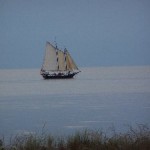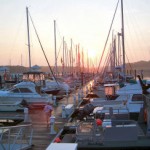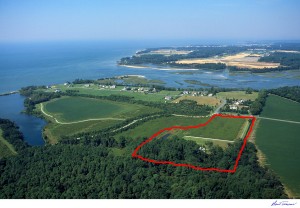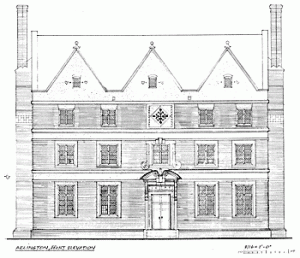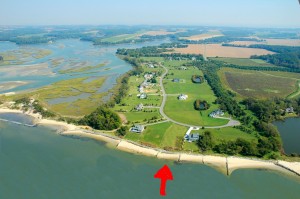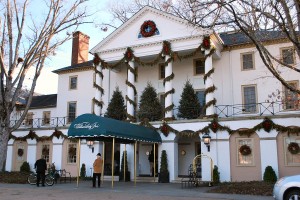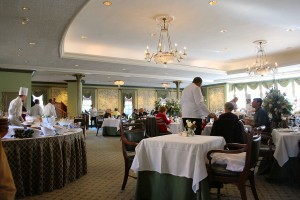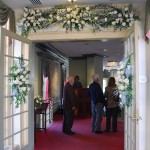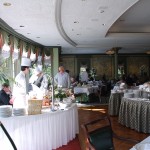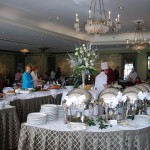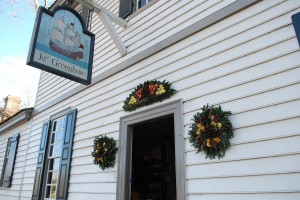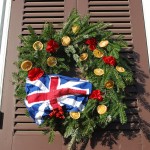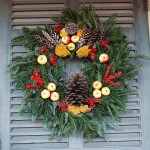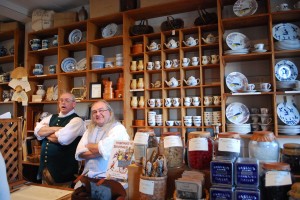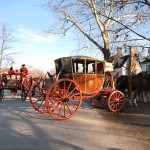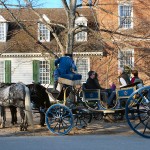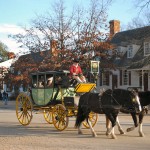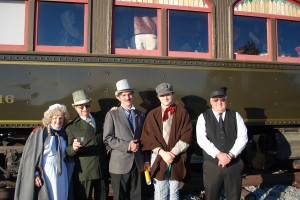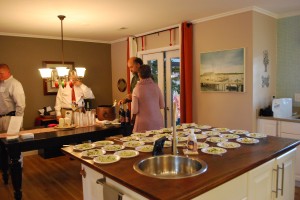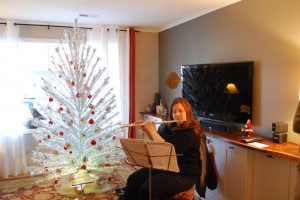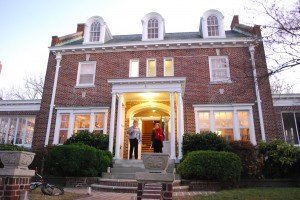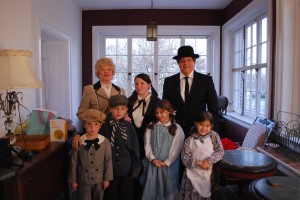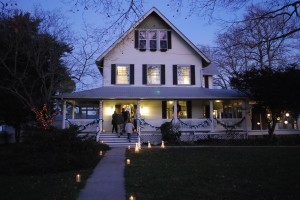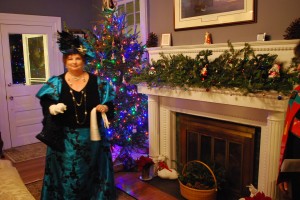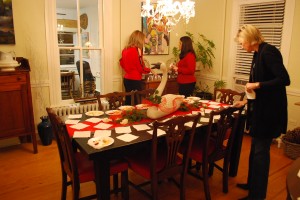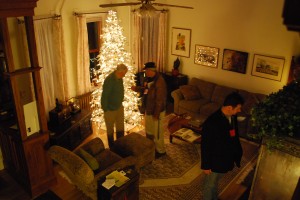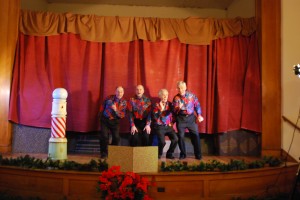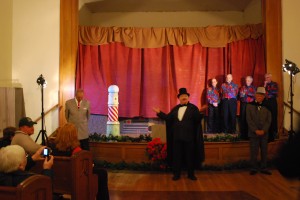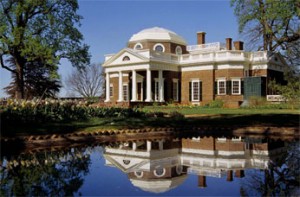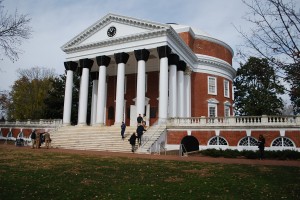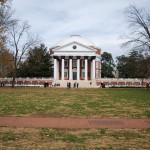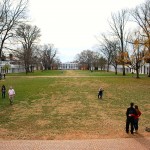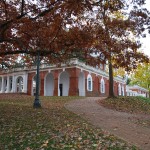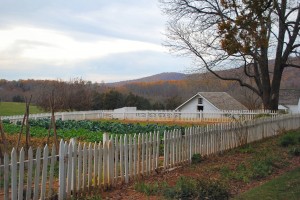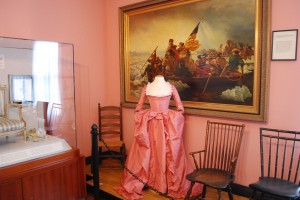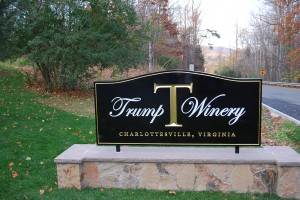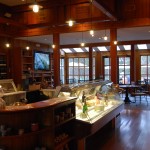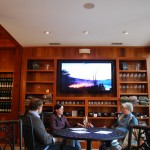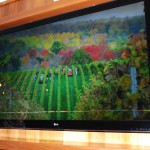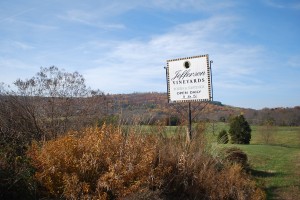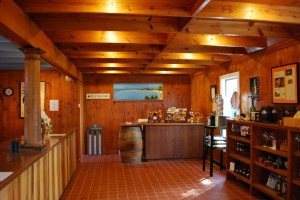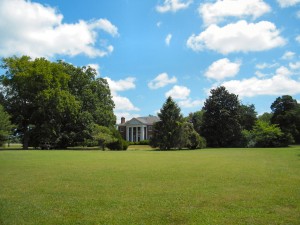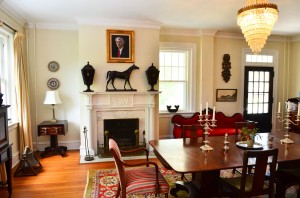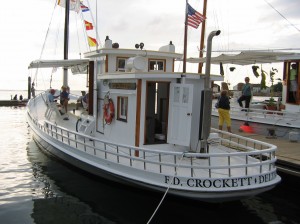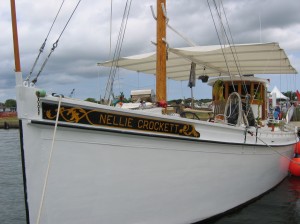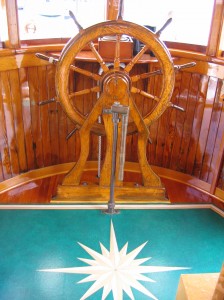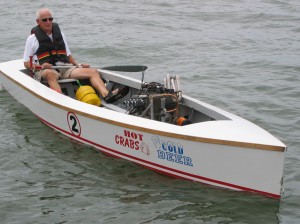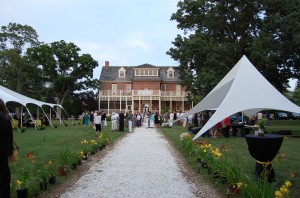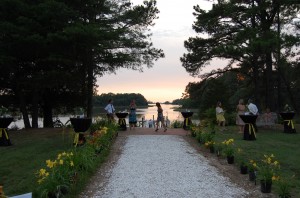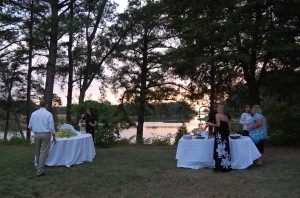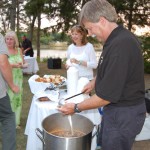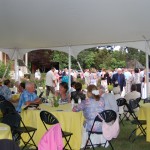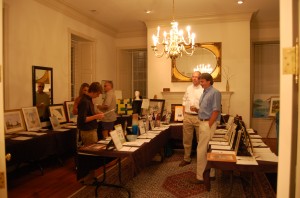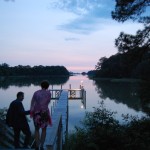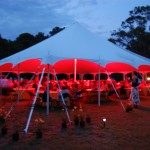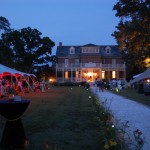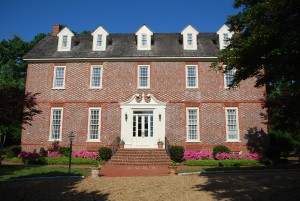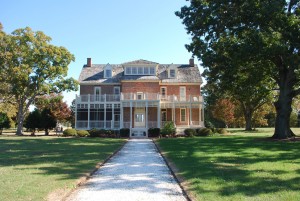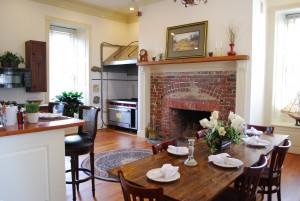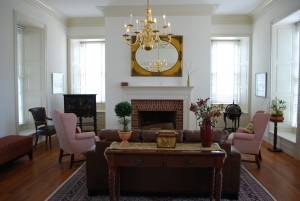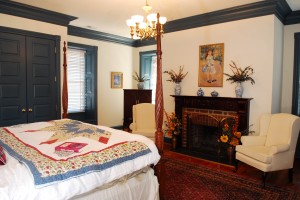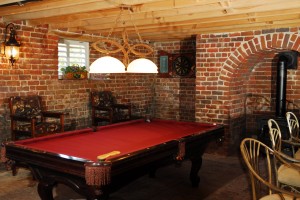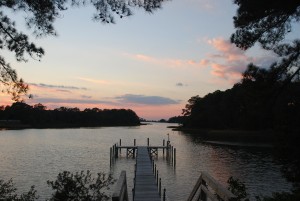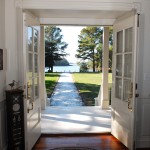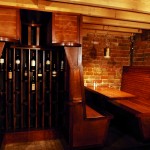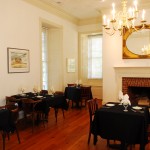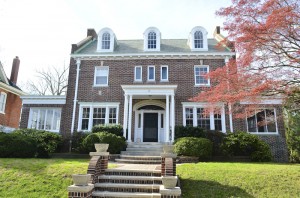
The Kellogg House at 644 Monroe Ave., Cape Charles, VA
Arguably the finest house in the historic Chesapeake Bayfront town of Cape Charles, Virginia , the Kellogg House at 644 Monroe Avenue, remains for my children their cherished residence, full of childhood memories. From elementary school-aged children to high schoolers, this house was the center of their universe for eleven years. Having spent over 4,000 nights there, I have a unique appreciation for its particular special history, qualities and features completely aside from the special amenities in Cape Charles such as the great town beach, Palmer and Nicklaus world class golf courses and a new state-of-the-art marina. And believe me, there hardly was a morning that I did not awaken with the feeling of how privileged I was to live in such a fine old home!
She never fails to impress a new visitor that crosses her threshold. From the moment one stands
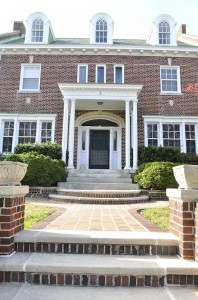
Grand Entrance Portico at the Kellogg House
on the sidewalk out front gazing up at her parapets, this grand lady calls, welcoming one to climb the granite steps to the front portico supported by pairs of twin Doric columns. A great big door with lionshead knocker guards the entrance that is lined with leaded glass-paned sidelights and fan light above. Dropping the bar on the knocker sends a resounding clap echoing down the entrance hall and up the grand staircase. My memory recalls the kids bounding down the stairs to answer the door, ready for friends and play.
Mr. Eucebius Milton Kellogg completed the construction of this magnificent house in 1928, two years after sinking the massive foundation that supports the impressive brick and steel structure of the home. I understand that 6 months was spent on this foundation, driving contiguous pilings deep into the footprint upon which the concrete footers were poured. As the basement is at ground level, mounds of earth were piled high up against the front walls, giving the impression from the street the home is built on a hill. Mr. Kellogg was a railroad tycoon and wanted his final home to last for centuries! Walls three and four bricks thick stand upon the poured footers and threaded throughout each of the three floors of the home are 12″ steel I-beams. No big, bad wolf is going to blow this house away!
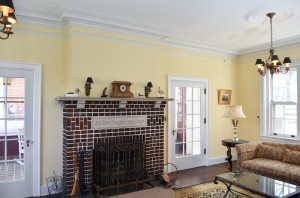
Massive masonry fireplace and French doors in living room
Great, big, formal spaces lend an air of elegance and are finished with architectural moldings, up to five pieces hand-fitted together.
In the center of the outer wall of the living room is a grand masonry fireplace with stone mantel and carved insert in French script. On either side of the massive fireplace, a fireplace that warmed my cold feet on many winter nights, are big French doors offering easy access to the Spanish tiled Florida room.
This sun porch has these incredible horizontal stacking windows that open up great expanses of screened airflow. And on the other side of the great center hall is a wonderful dining room with a centerpiece
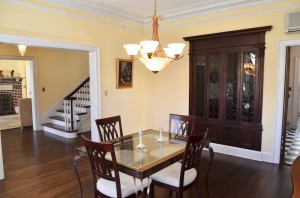
Dining room with mahogany china cupboard
that is a beautiful, handcarved, solid mahogany china cupboard. For excellent service, right behind the dining room is the best butler pantry I have ever seen, with floor to ceiling wooden and glass cupboards and an original, five foot long porcelain sink. The back hall has another fantastic gem that never fails to amaze, a floor to ceiling Frigidaire ice cream cupboard,
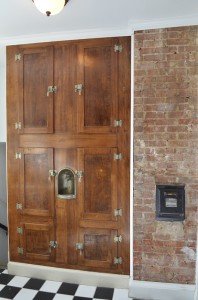
Floor to ceiling ice cream cupboard in back hall
magnificently refinished to attract the attention it deserves. Two sets of back stairs lead down to the basement and out into the back yard. The great kitchen also has the same type of stacking windows as the Florida room and allows for wonderful ventilation while preparing and cooking food. Between the kitchen and the dining room and just off the butler pantry is another little surprise, a charming, tiled breakfast room surrounded by six paned, double hung windows that bring the soft morning light and outdoors inside. And off the dining room is a cute, little tiled screened porch, one where I often slept on an army cot during hot summer nights.
Yes, the kids sounded like herds of elephants trampling up and down the grand, cantilevered staircase, a sound that took me years to get used to, but that I miss so much now that they are grown up and on their own. These wonderful stairs always amazed me by their seemingly weightless suspension, but how graceful they
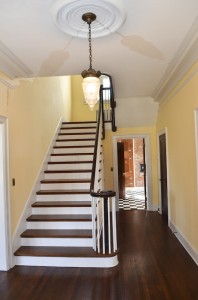
Wonderfully engineered cantilevered grand staircase
are, appointed with a beautiful mahogany bannister with curled end at the bottom. At each of the three floors is an access door that opens to the laundry chute for conveniently making soiled, and in the case of lazy children, not so soiled clothes disappear down to the laundry room in the basement.
The suite of rooms on the second floor tell an interesting story about an elderly couple whose children had all left home before they designed and built this house. Mr. and Mrs. Kellogg had two daughters that they raised in the home at 653 Tazewell, just a hop, skip and a jump from the location of this, their new Monroe Avenue mansion. There they lived for thirty-five years before moving into this home, their final place of residence. Settled into their dream home in 1928, Mr. Kellogg occupied one half of the second floor in a large bedroom served by a built-in wardrobe with glass paned doors and a bathroom with shower finished with subway tile. This was heated by a radiator hidden behind a massive iron screen ornamented with two
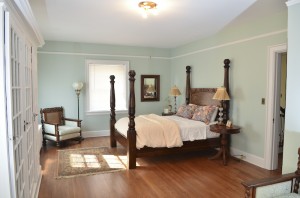
Master bedroom with built-in wardrobe
hundred flur-de-lis. The other half of this floor was occupied by Mrs. Kellogg, a suite of three rooms – one a corner bedroom with attached tiled bathroom with full sized tub and pedestal sink and same flur-de-lis radiator screen. The middle room was clearly her full sized dressing and sitting room and passing though that past a huge cedar closet is the sleeping porch for those hot summer nights before the age of air conditioning. And outside that is an outdoor patio as high
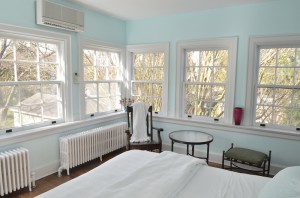
Sleeping porch at the Kellogg House
as the tops of the huge crepe myrtles in the back yard – a perfect place for sunbathing!
The third floor was clearly designated for two servants to live in, with two identical bedrooms and a full bath with huge tub between the two. All three of these rooms are served with identical dormers with curved-topped French windows that peak out over the street scene far below. The curved plaster-on-lathe ceilings are so gracefully formed, yet the floors here are only common heart-pine while the two more formal floors below have beautiful oak hardwood. I could continue on and on with more details about this unique and beautiful home but I shall save the rest for a future post. However, should you be interested in making an appointment to see this splendid and lovingly constructed historic Cape Charles home, please give Blue Heron a call at 757-331-4885 or email me at davidk@esva.net.
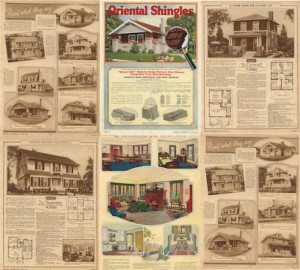 Through the years Sears maintained a selection of some eighty house plans that were updated to keep abreast of developing trends and for the sake of variety. The plans ran from the smallest sized bungalow to a number of truly substantial models including the elaborate “Magnolia”, which for about $5.000, offered ” Eight rooms and two and a half baths. Two story portico with fluted columns; open terrace across the front, side porte-cochere; decks and sleeping porch off second floor bedrooms; glazed front porch with sidelights and arched transom. Fireplace and nook in living room; French doors off hall; open stairs” . But, in general, the majority of their designs were in keeping with the popular American tastes of the period and were designed to have broad appeal by offering a quality modern home for an affordable price. For extra flexibility, most home plans in their catalogs were able to be ordered in reverse layouts. The styles of the homes seem to almost always follow recognizable architectural traditions. The gambrel roof was a mainstay of the Dutch Colonial style. Roofs with steep pitches evoked English ancestry. The most popular style though, by far, was the well-liked American Colonial, rivaled only by the “bungalow” concept.
Through the years Sears maintained a selection of some eighty house plans that were updated to keep abreast of developing trends and for the sake of variety. The plans ran from the smallest sized bungalow to a number of truly substantial models including the elaborate “Magnolia”, which for about $5.000, offered ” Eight rooms and two and a half baths. Two story portico with fluted columns; open terrace across the front, side porte-cochere; decks and sleeping porch off second floor bedrooms; glazed front porch with sidelights and arched transom. Fireplace and nook in living room; French doors off hall; open stairs” . But, in general, the majority of their designs were in keeping with the popular American tastes of the period and were designed to have broad appeal by offering a quality modern home for an affordable price. For extra flexibility, most home plans in their catalogs were able to be ordered in reverse layouts. The styles of the homes seem to almost always follow recognizable architectural traditions. The gambrel roof was a mainstay of the Dutch Colonial style. Roofs with steep pitches evoked English ancestry. The most popular style though, by far, was the well-liked American Colonial, rivaled only by the “bungalow” concept.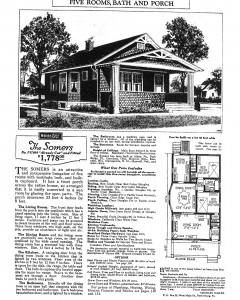 The building of houses in America prior to World War II reached its peak in 1925, but Sears home offerings would continue to expand through 1929, the year of the great crash of the stock market. By 1930, across the nation, Sears had opened 48 sales offices employing over 350 salesmen. Their 1926 catalog was a masterful marketing piece, presenting their products in color and with exceptionally glowing remarks about the product attributes. Even the type of wood used in the construction of the homes was referenced because of the interest created by the then recent discovery of well-preserved cypress found in King Tut’s tomb. The Sears Modern Home catalog descriptions addressed every concern imaginable, from the basic reasons for buying a home to touting the then unusual and innovative step of the company’s placement of a woman on the Sears Architect’s Council because she “would understand the needs of the modern housewife.” Nobody imagined that this incredible line of prefabricated housing would last only eight more years. The 1930’s brought the first losses after nineteen consecutive years of profitability. No matter what great ideas Sears employed in supporting its line, the effects of the Great Depression could not be overcome. The first division to fail was the home mortgage industry where, as the “farmer’s friend”, Sears had loaned generous amounts of up to 100% of the cost of a home’s construction. But by 1934, Sears had proudly delivered more than 100,000 housing units throughout the United States, very high quality homes, professionally designed and planned for a lifetime of use by their owners.
The building of houses in America prior to World War II reached its peak in 1925, but Sears home offerings would continue to expand through 1929, the year of the great crash of the stock market. By 1930, across the nation, Sears had opened 48 sales offices employing over 350 salesmen. Their 1926 catalog was a masterful marketing piece, presenting their products in color and with exceptionally glowing remarks about the product attributes. Even the type of wood used in the construction of the homes was referenced because of the interest created by the then recent discovery of well-preserved cypress found in King Tut’s tomb. The Sears Modern Home catalog descriptions addressed every concern imaginable, from the basic reasons for buying a home to touting the then unusual and innovative step of the company’s placement of a woman on the Sears Architect’s Council because she “would understand the needs of the modern housewife.” Nobody imagined that this incredible line of prefabricated housing would last only eight more years. The 1930’s brought the first losses after nineteen consecutive years of profitability. No matter what great ideas Sears employed in supporting its line, the effects of the Great Depression could not be overcome. The first division to fail was the home mortgage industry where, as the “farmer’s friend”, Sears had loaned generous amounts of up to 100% of the cost of a home’s construction. But by 1934, Sears had proudly delivered more than 100,000 housing units throughout the United States, very high quality homes, professionally designed and planned for a lifetime of use by their owners.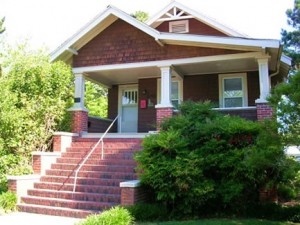 The Town of Cape Charles on Virginia’s Eastern Shore has a number of authentic Sears homes, most restored and well-preserved. For sale by Blue Heron Realty Co. is a reverse plan of the Somers Model ordered from the 1926 catalog and found at 3 Randolph Ave., just a hop, skip and a jump from the Chesapeake Bay and the beautiful Cape Charles town beach. Professionally restored and renovated for modern living, this home is a terrific example of the very popular Sears bungalow style. Elevated well above eight feet from grade level, this front porch enjoys a wonderful view out towards the western horizon of the Bay. The ground floor of the home consists of a solid masonry, red-brick foundation for the actual kit home which makes up the second level. The kit home has beautiful cedar wood shingle siding protected with a weather-proof stain that retains the wood grain and color. Also, energy efficient, double pane insulated windows have been installed. Built on two town residential lots, there is a paved driveway, spacious yard with mature plantings, and an access alley behind the home that serves for utility and service access.
The Town of Cape Charles on Virginia’s Eastern Shore has a number of authentic Sears homes, most restored and well-preserved. For sale by Blue Heron Realty Co. is a reverse plan of the Somers Model ordered from the 1926 catalog and found at 3 Randolph Ave., just a hop, skip and a jump from the Chesapeake Bay and the beautiful Cape Charles town beach. Professionally restored and renovated for modern living, this home is a terrific example of the very popular Sears bungalow style. Elevated well above eight feet from grade level, this front porch enjoys a wonderful view out towards the western horizon of the Bay. The ground floor of the home consists of a solid masonry, red-brick foundation for the actual kit home which makes up the second level. The kit home has beautiful cedar wood shingle siding protected with a weather-proof stain that retains the wood grain and color. Also, energy efficient, double pane insulated windows have been installed. Built on two town residential lots, there is a paved driveway, spacious yard with mature plantings, and an access alley behind the home that serves for utility and service access.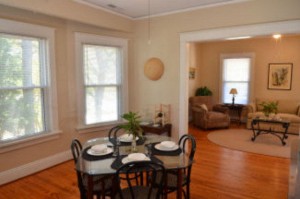 Inside, one is suitably impressed by the beautifully refinished original red oak and pine hardwood floors, a bay window in the dining room, a modern kitchen and two bedrooms served by one bath. A heat pump supplies central forced air heat and A/C for the upstairs portion of the house, while beautiful ceiling fans provide the comfort of moving air. The entire home has been updated and renovated for modern living yet retains its historic appeal. A stairwell leads down from the second floor to a first floor apartment with its own kitchen, great room, two bedrooms, a bath and storage area. One may retain the official duplex status of the home or restore it back to a single family house. At present, the upper level which comprises the kit home is offered for weekly summer vacation rental while the lower floor is rented from month to month.
Inside, one is suitably impressed by the beautifully refinished original red oak and pine hardwood floors, a bay window in the dining room, a modern kitchen and two bedrooms served by one bath. A heat pump supplies central forced air heat and A/C for the upstairs portion of the house, while beautiful ceiling fans provide the comfort of moving air. The entire home has been updated and renovated for modern living yet retains its historic appeal. A stairwell leads down from the second floor to a first floor apartment with its own kitchen, great room, two bedrooms, a bath and storage area. One may retain the official duplex status of the home or restore it back to a single family house. At present, the upper level which comprises the kit home is offered for weekly summer vacation rental while the lower floor is rented from month to month.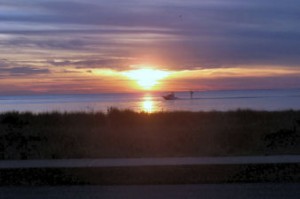 Life in the Town of Cape Charles is truly the “sweet beach life ” ! One of the few places on the East Coast of the United States where one can observe a beautiful sunset to the west over a saltwater Bay. Easily accessible from this bungalow is the boardwalk and “fun pier” from which observations of boats, kite board surfers and the local bird life are frequently found. Nearby are the public boat ramps and municipal and private marinas, world-class, intersecting Palmer and Nicholas designed golf courses, eclectic shopping and restaurants, and our very special historic Palace Theater, one of the best performing arts venues in Virginia. Only a few miles east of Town is the village of Oyster which is perched on the seaside of our penninsula and offers access to an entirely different marine ecosystem. Interests in colonial history, the performing and visual arts, nature exploration and photography, boating and fishing, architecture, gardening, bicycling, hiking, swimming, and especially birdwatching are eagerly pursued here. Come and try on this incredible lifestyle offered from such a wonderful residence as this historic Sears and Roebuck Catalog home. For further information on this listing and other properties for sale in Cape Charles and on the Eastern Shore of Virginia, contact David Kabler via e-mail ( david_kabler@hotmail.com) or via mobile (757) 647-1755.
Life in the Town of Cape Charles is truly the “sweet beach life ” ! One of the few places on the East Coast of the United States where one can observe a beautiful sunset to the west over a saltwater Bay. Easily accessible from this bungalow is the boardwalk and “fun pier” from which observations of boats, kite board surfers and the local bird life are frequently found. Nearby are the public boat ramps and municipal and private marinas, world-class, intersecting Palmer and Nicholas designed golf courses, eclectic shopping and restaurants, and our very special historic Palace Theater, one of the best performing arts venues in Virginia. Only a few miles east of Town is the village of Oyster which is perched on the seaside of our penninsula and offers access to an entirely different marine ecosystem. Interests in colonial history, the performing and visual arts, nature exploration and photography, boating and fishing, architecture, gardening, bicycling, hiking, swimming, and especially birdwatching are eagerly pursued here. Come and try on this incredible lifestyle offered from such a wonderful residence as this historic Sears and Roebuck Catalog home. For further information on this listing and other properties for sale in Cape Charles and on the Eastern Shore of Virginia, contact David Kabler via e-mail ( david_kabler@hotmail.com) or via mobile (757) 647-1755.
